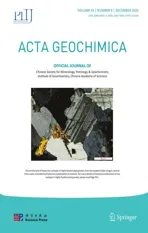Peraluminous granitoids within the Hangloa area, Adamawa-Yadé Domain, Cameroon: Petrogenesis and tectonic implication
2022-12-22YayaFodouMeroYannahRigobertTchameniWadjouJacquesWassouoAmadouDiguimKepnamouJosephPenayeAbakarMahamatEmmnuelNomoNegue
Yaya Fodoué · Mero Yannah · Rigobert Tchameni · Wadjou Jacques Wassouo · Amadou Diguim Kepnamou ·Joseph Penaye · Abakar Mahamat · Emmnuel Nomo Negue
Abstract Hangloa granitoids form part of the wide range calc-alkaline Pan-African granitic suites within the Adamawa Yade Domain (AYD) in Cameroon.There are several reports on metaluminous granitoids within this domain.The peraluminous suite has been locally reported and their petrogenesis is not fully understood.Petrography and whole-rock geochemistry were used to study the petrogenesis/formation of granitic rocks within this area.The results show that the granitoids are composed of quartzo-feldspathic, made up of granites, monzonites and quartz monzonites which were intruded in the Paleoproterozoic orthogneissic basement.The major and trace element compositions show that they are high-K calc-alkaline to shoshonites, with S-type affi nity.The molar ratio A/CNK is > 1.1, while the ratio of CaO + Na 2 O/Al 2 O 3 is generally < 1 making them strongly peraluminous.The REE shows enrichment in the LREE over the HREE, with (La/Yb) N varying from 11.9 to 53.32,(Dy/Yb) N from 0.77 to 2.13 and moderately negative Eu anomaly ((Eu/Eu*) N range from 0.42 to 0.93).Most granite samples show depletion in P, with CaO/Na 2 O < 0.3 and Rb/Sr ≤ 1 indicative of clay-poor metapelitic source, while the others show clay-rich metagreywackes sources.The strong peraluminosity, S-type affi nity, high Ba/Sr, Ba/Rb and low Rb/Sr indicate they are crustal-derived.The compositional variation might be induced by the partial melting of diff erent source materials followed by fractional crystallization of the granitic magma.The source nature requires fragments of Paleoproterozoic metasedimentary and metaigneous rocks derived from the collision between the northcentral Cameroon block and the Congo Craton during the Pan-African.
Keywords Petrography · Geochemistry · Peraluminous ·Hangloa · Adamawa-Yade-Domain
1 Introduction
Peraluminous magmas are gradually becoming a major topic of interest in geosciences.Their petrogenesis and tectonic settings are strongly related to that of S-type granites often considered to be synonymous (White et al.2001;Bucholz and Spencer 2019).However, their association with disseminated, pegmatite and vein-type deposits coupled with their high potential for skarn-type mineralization(tin, tungsten, zinc) make them of more practical interest(Zen 1988).Peraluminous granitic rocks, as def ined by Zen( 1988) include magmatic rocks that contain quartz, potassium feldspar and/or sodic feldspars alongside one or more aluminum-rich minerals.Even though the consensus recognized the metasedimentary source for strongly peraluminous granitic rocks, their tectonic setting is still a subject of debate (Patino Douce and Johnston 1991; Collins and Richards 2008).According to Villasseca et al.(2008), the origin of peraluminous granitic rocks is faced with several challenges, including; the contamination process during magma transport and emplacement, nature of the rocks protolith, the incorporation of residual material and/or inherited components, temperature and pressure conditions involved during magma generation, crystallization and magma differentiation processes (crystal fractionation, magma mixing,volatile Exsolution).The Adamawa-Yadé-Domain (AYD)of the Cameroon Central African Fold Belt (CAFB) is characterized by a variety of granitic rocks mainly displaying metaluminous to weakly peraluminous character (Nguiessi-Tchamkam et al.1997; Tagne-Kamga et al.1999; Tagne-Kamga 2003; Njanko et al.2006; Tchameni et al.2006;Djouka-Fonkwé et al.2008; Kwékam et al.2010, 2013;Ngoniri et al.2020; Assomo et al.2021).This area falls in the AYD separated from the Western Cameroon Domain(WCD) by the Tcholliré-Banyo Fault (TBF).Even though the TBF is considered the limit between the two domains,there are great similarities that exist between granitoids from both sides (Njanko et al.2006; Tchameni et al.2006;Ganwa et al.2011; Kouankap Nono et al.2018; Yannah et al.2019) especially in their high-K calc-alkaline to shoshonite character, metaluminous I-type affi nity and syn- to post-collisional settings.The occurrence of strongly peraluminous granitic rocks within the AYD has not been well recognized even though the neighbouring WCD host some of the strongly peraluminous granitoids in the Nkambe and Akum-Bamenda areas (Djouka-Fonkwé et al.2008; Nzenti et al.2010).The proximity of the Hangloa area (Fig.1) to the TBF, which is a regional structure recognized as a major tectonic margin of the CAFB in Cameroon, and the close link to the Poli schist belt (Toteu et al.2001) makes it a suitable environment for the emplacement of peraluminous magmas.In this regard, this work was designed with the approach of using petrography and whole-rock geochemistry to constrain the occurrence, source and tectonic setting of peraluminous granitic rocks in this part of the AYD.
2 Geological setting
The study area Hangloa falls within the Adamawa-Yadé Domain (AYD) (Toteu et al.2004) and forms part of the Central African Fold belt in Cameroon alongside the WCD on the north and the Yaounde Domain (YD) on the south(Toteu et al.2004) (Fig.1 b).These geotectonic units(Fig.1 a) were derived from the collision of the São-Francisco Craton, Congo Craton, Eastern Saharan Block and the West African Craton (Ngako and Njonfang 2011; Van Schmus et al.2008; Ngako et al.2008; Castaing et al.1994).It is considered that the AYD rests on a Paleoproterozoic basement that was torn apart during the Pan-African orogeny (Toteu et al.2004).This basement show signif icant age similarity to Archean crust hosting diff erent Neoproterozoic syn- to late tectonic granitoids (Lasserre 1961; Tagne Kamga et al.1999; Nzolang et al.2003; Tanko Njiosseu et al.2005; Toteu et al.2001; Tchameni et al.2006; Ganwa et al.2011; Ngoniri et al.2020; Assomo et al.2021) alongside the Poli and Lom schists belts (Soba et al.1991; Penaye et al.1989; 1993; Toteu et al.2001; 2004; Tchaptchet Tchato et al.2009).However, the Hangloa area is found in a lake basin proximal to the Poli metasedimentary basin of Neoproterozoic age (Toteu et al.2006).The regional Central Cameroon Shear Zone (CCSZ) forms an integral part of the AYD, with the Sanaga Fault (SF) forming its southern limit trending NE-SW (Toteu et al.2004; Njanko et al.2006;Ngako et al.2008).The CCSZ though generally def ined as a N70°E structure (Ngako 1999; Ganwa et al.2005; Ngako et al.2008), has a geometry that extends from N40°E within the Tikar plain, curving progressively through N60°E to N70°E (Njonfang et al.2008).Previous studies show that the CCSZ forms a lithological boundary that separates the juvenile Paleoproterozoic on the northern side from the ortho-Paleoproterozoic on the southern side, with bands of Mesoproterozoic units sandwiched within this CCSZ as fault rocks (Makitie et al.2019).The Paleoproterozoic crust host granitic intrusions within the AYD.These granitic rocks have been broadly described into three main groups(Lasserre 1961; Toteu et al.2001; Tchameni et al.2006):(1) pre-tectonic granitoids completely transformed into orthogneisses with varying structures and petrography; (2)syn-tectonic granitoids that commonly bear enclaves of the previous formations, heterogeneous in composition, calcalkaline with meta- to peraluminous affi nity (Ganwa et al.2011); (3) post-tectonic granitoids common in the Ngaoundere area varying from 640 to 560 Ma old (Tchameni et al.2006; Ganwa et al.2008).They are partially covered by recent basaltic lava (Ganwa et al.2008).TBF: Tcholliré-Banyo Fault, WCD: Western Cameroon Domain,AYD: Adamawa-Yadé Domain, YD: Yaounde Domain, CCSZ: Central Cameroon Shear Zone, NC: Ntem Complex, DS: Dja Series, NS:Nyong Series; CCSZ: Central Cameroon Shear Zone; GGSZ: Godé Gormaya Shear Zone; MNSZ: Mayo Nolti Shear Zone

Fig.1 (a) Main structural domains of West-central Africa and northern Brazil (Castaing et al.1994; Toteu et al.2004; Tchameni et al.2006); (b) Geological map of Cameroon showing the main geotectonic domains and structures (Toteu et al.2001, 2004; Tchameni et al.2006).AF: Adamawa Fault, KCF: Kribi-Campo Fault, SF: Sanaga Fault,
3 Samples, analytical methods and petrography
3.1 Field and laboratory work
This study began with f ieldwork during which lithological outcrops were identif ied and described texturally, structurally and mineralogically.Representative samples from each rock type were sampled for further analysis.Thirty representative samples of the diff erent rock types were selected for thin section preparation.These thin sections were prepared and studied at the Geoscience Laboratories in Toulouse (LGT) France under L’Agence Universitaire de la Francophonie (AUF) project.Further observation and interpretation of the thin sections were carried out at the University of Ngaoundere and the Center of Geological and Mining Research (CRGM), Garoua Cameroon, for detailed textural and mineralogical analysis.For the geochemicalstudy, 17 samples were analyzed at ACME Laboratories,Vancouver, Canada, using ICP-AES (Inductively Coupled Plasma - Atomic Emission Spectroscopy).0.2 g of rock powder was fused with 1.5 g LiBO2and then dissolved in 100 mm3of 5% HNO3.The rare earth element (REE) contents were determined by ICP-MS from pulps using 0.25 g rock powder, dissolved by 4 acid digestions.Analytical precisions vary from 0.1 to 0.04% for major elements, 0.1 to 0.5 ppm for trace elements and from 0.01 to 0.5 ppm for rare the earth elements.

Fig.2 Geological map of Hangloa area showing lithological relationships.(redrawn from Bernard et al.2019)
3.2 Petrography
Field and petrographic analysis show that the study area comprises of deformed granitic basement (orthogneisses)that hosts three plutonic rocks.These include monzonites,quartz monzonites and granites (Fig.2).
a) Orthogneisses
Orthogneisses are form the basement lithology of the area and outcrop as bedrocks, especially in the Margol stream (north of the study area), and extend towards the central part of the study area.They are also form enclaves in the granites and quartz monzonites.These gneisses show compositional banding with alternating light and dark bands(Fig.3 a).At outcrop scales, the felsic (light) band varies in thickness from 2 to 30 cm, while the maf ic (dark) bands are thinner, ranging from 1 to 10 cm.
Photomicrographs of the gneisses show medium to coarse-grained texture, continuous schistosity, no microlithons, and over 30% cleavage domain (Passchier and Trouw 2005).Their colour is grey to dark grey bearing quartz, plagioclase, k-feldspars, biotite and amphibole.These minerals generally show inequigranular-interbolate grain boundaries.Foliation in these gneisses is def ined by the preferred alignment of biotite and amphibole minerals,rough to smooth cleavage domain.Quartz forms subgrains and inclusion in plagioclase and k-feldspars.K-feldspar shows irregular grain margin, moderate to low sericite alteration and locally display perthite structures.Amphibole is blue-green with less than 2 mm grain size occurring in association with biotite which is dark-brown and lath-like,measuring less than 3 mm.
b) Granites

Fig.3 Photomicrographs of Hangloa granitoids; a) orthogneiss; b & c) granite; d) monzonite; e & f) quartz monzonite.Mineral code adopted from Whitney and Evans (2010): Amp: Amphibole; Bi: Biotite; Ky: kyanite; Mi: Microcline; Ox: Oxide; Per: Perthite; Pl: Plagioclase; Qz: Quartz
In the Hangloa area, the intrusive rocks are dominated by granites.They outcrop south of the study area, forming small plutons with two prominent ones measuring 1100 to 1250 m high and known by the names “Hosséré Laounga”and “Hosséré Taparé” respectively.These granites contained enclaves of orthogneisses and are commonly crosscut by basaltic dykes.They are medium (1‒4 mm) to coarse(> 10 mm) -grained, commonly porphyritic, pinkish, and composed of quartz, k-feldspars, plagioclase, biotite and kyanite (Fig.3 b‒f).The texture of the granites shows quartz(20–25%) with subhedral to anhedral and granular grains occurring in clusters.Some of the quartz form inclusion in the k-feldspars.k-feldspar appears as pink orthoclase, and microcline in the rocks commonly display perthite structure with resorbed grain boundaries.Most K-feldspar grains show > 60% perthite structure.Plagioclases show subhedral grains with locally altered rims.Biotite occurs in small clusters and as isolated grains with irregular margins.Finer biotite grains occupy the mineral interstices.Kyanite is a rare mineral in these granites.
It occurs in association with k-feldspars, opaque minerals and locally with biotite displaying a bladed crystal habit(Fig.3 c).Accessory minerals include opaque minerals and/or oxides, zircon and titanite (< 4 vol%), forming inclusion in feldspars and quartz.
c) Monzonites
These granitoids outcrop on the south and southwestern part of the study area in the form of boulders, blocks and bedrock commonly cross-cut by basaltic dykes.They are coarse-grained (> 10 mm), grey to light grey, and contain 4‒5 vol% quartz, occurring in small clusters.Isolated quartz grains show dissolved margins.The monzonites are rich in k-feldspar (45‒50 vol%) in the form of orthoclase and microcline (Fig.3 c).Both k-feldspars commonly display f lame perthite structures, with irregular grain boundaries bearing quartz inclusions.Plagioclase (40‒45 vol%) occurs mainly as isolated grains within the k- feldspars.Biotite(< 5 vol%) occurs as the main ferromagnesian mineral in the rock, occupying mineral interstices and as single isolated grains.Accessory minerals include zircon, titanite and apatite, forming inclusions in the feldspars and occupying mineral interstices.
d) Quartz-monzonites
Quartz-monzonites are the second most abundant rocks in the area They outcrop in the Margol steam on the northwest of the study area in the form of blocks and bedrocks.They are light-grey, coarse-grained (8‒10 mm), and locally porphyritic with an average phenocryst size of 0.5 cm.Photomicrographs show the rock with quartz (10‒15 vol%)displaying granular grains often in clusters (Fig.3 e & f).Isolated quartz grains show irregular margins, and locally form inclusions in k-feldspars.However, around k-feldspar phenocryst, secondary quartz cluster at the margins ofperthite k-feldspar grains (Fig.3 e).Plagioclase is relatively abundant in the rock (30–40 vol%) and display medium to large subhedral grains (4‒8 mm) interconnected with quartz and k-feldspars.Some plagioclases commonly show intergrowth amongst crystals and bear the most opaque mineral inclusions.Orthoclase and microcline are the main K-feldspars in these rocks, constituting 35‒45 vol%.Grains measure up to 10 mm large, commonly subhedral and locally bear f lame perthite structures, while sericite alteration is common at grain margins.Inclusions of accessory minerals like apatite, zircon and titanite are common in these feldspars.Biotite occurs in isolation as the ferromagnesium phase, mostly within mineral interstices.Meanwhile, secondary minerals like chlorite, sericite, epidote and opaque minerals occupy grain boundaries and mineral interstices.

Fig.4 Classif ication of granitoids using TAS (Middlemost 1984)(SiO 2 vs.Na 2 O + K 2 O) diagram
4 Results
4.1 Geochemistry
a) Major oxidesThe granitoids of the Hangloa area show the presence of biotite and amphibole-bearing orthogneisses that host abundant granites accruing in association with monzonites and quartz monzonites (Fig.4).The orthogneisses show granite and quartz monzonites protoliths (Middlemost 1994).These rocks show signif icant variation in their chemical composition (Table 1).The granitoids are high in silica and alumina content, with SiO2ranging from 56.9 to 76.4 wt%and Al2O3from 12.28 to 18.7 wt%.Their Fe2O3content is equally high, ranging from 1.09 to 3.16 wt% in the granites and 6.3–8.9 wt% in the other granitoids plotting the rocks at the transition f ield between ferrous and magnesian f ields(Fig.5 c).MgO is low to moderate, ranging from 0.1 to 2.62 wt%, with the granites having the lowest values.CaO is < 2 wt% in the granites, while the orthogneisses, monzonites and quartz monzonites contain between 2 and 2.62 wt%.Na2O and K2O are moderate to high, with values ranging from 3.7 to 4.7 wt% and 2.11‒5.23 wt%, respectively.This gives a molar proportion of Al2O3/CaO + Na2O + K2O (A/CNK) that varies from 1.1 to 1.96, with an overall molar Na2O + K2O/Al2O3(NK/A) < 1 (Table 1).The granites show low TiO2content of < 2 wt% and between 0.8 and 1.93 in the other rocks.MnO is generally > 1 wt% in these rocks.In general, the major oxides (Fe2O3, MgO, Al2O3, CaO, TiO2,P2O5and MnO) negatively correlate with SiO2except for Na2O and K2O which show scattering, with a slightly positive correlation (Fig.6).Their moderate to high total alkali(5 vol% < K2O + Na2O < 9 vol%) content place them in the high-K calc-alkaline and shoshonite f ields (Fig.5 a), while their high aluminium saturation plot them into peraluminous S-type f ield (Fig.5 b).CaO/Na2O ratio for the granites is generally < 0.3, while monzonites, quartz monzonites and orthogneisses are > 0.3 except for sample Mb1, with CaO/Na2O of 1.16.

Fig.5 Geochemical characteristics of Hangloa granitoids; (a) SiO 2 vs.K 2 O by Peccerillo and Taylor ( 1976); (b) A/CNK vs.A/NK by Shand( 1943); (c) SiO 2 vs.FeOt/(FeOt + MgO) and ASI vs.A/NK of Frost et al.( 2001)
b) Trace and rare earth elements
Hangloa granitoids show a signif icant variation in their trace element content.The Large Ionic Lithophile Elements(LILE), including Ba (269‒1902 ppm), Rb (166‒233.8 ppm), Sr (89.2‒681.8 ppm) and Pb (9.3‒18 ppm), are relatively enriched compared to the High Field Strength Elements (HFSE) such as Hf (4.5‒13.8 ppm), Nb (13.2‒38.1 ppm), Ta (1‒1.9 ppm), Zr (10‒571.1 ppm), Th (20.6‒34.7 ppm) and U (4.6‒11.5 ppm).However, sample D2shows an exception with very low Ba (68 ppm) and Sr (44.9 ppm)levels.Hacker diagrams for selected trace elements versus SiO2show increasing trends for Ba and Sr, while Rb showsa decrease (Fig.5).The ratios of Rb/Ba vary from 0.1 to 0.87, Ba/Sr from 2.21 to 3.08 and Th/U from 3.02 to 5.36.Rb/Sr ratios for the orthogneisses, monzonites and quartz monzonites range from 1.35 to 2.62, while in the granites,the ratios are generally < 1.Sample D2 show an exception,with very high Rb/Sr = 6.1, Rb/Ba = 4.03 and very low Ba/Rb = 0.25.Rb/Ba ratioalso shows variation between the granites and the other rocks.Similarly, the rare earth elements (REE) show enrichments in the Light (LREE) over the Heavy (HREE) given by (La/Lu)Nvarying from 10.16 to 41.87, (Dy/Yb)Nfrom 0.77 to 2.13 (Table 1).All the rocks samples show depletion in Eu with a moderate to strong negative Eu-anomaly, given by (Eu/Eu*)Nranging from 0.42 to 0.93.
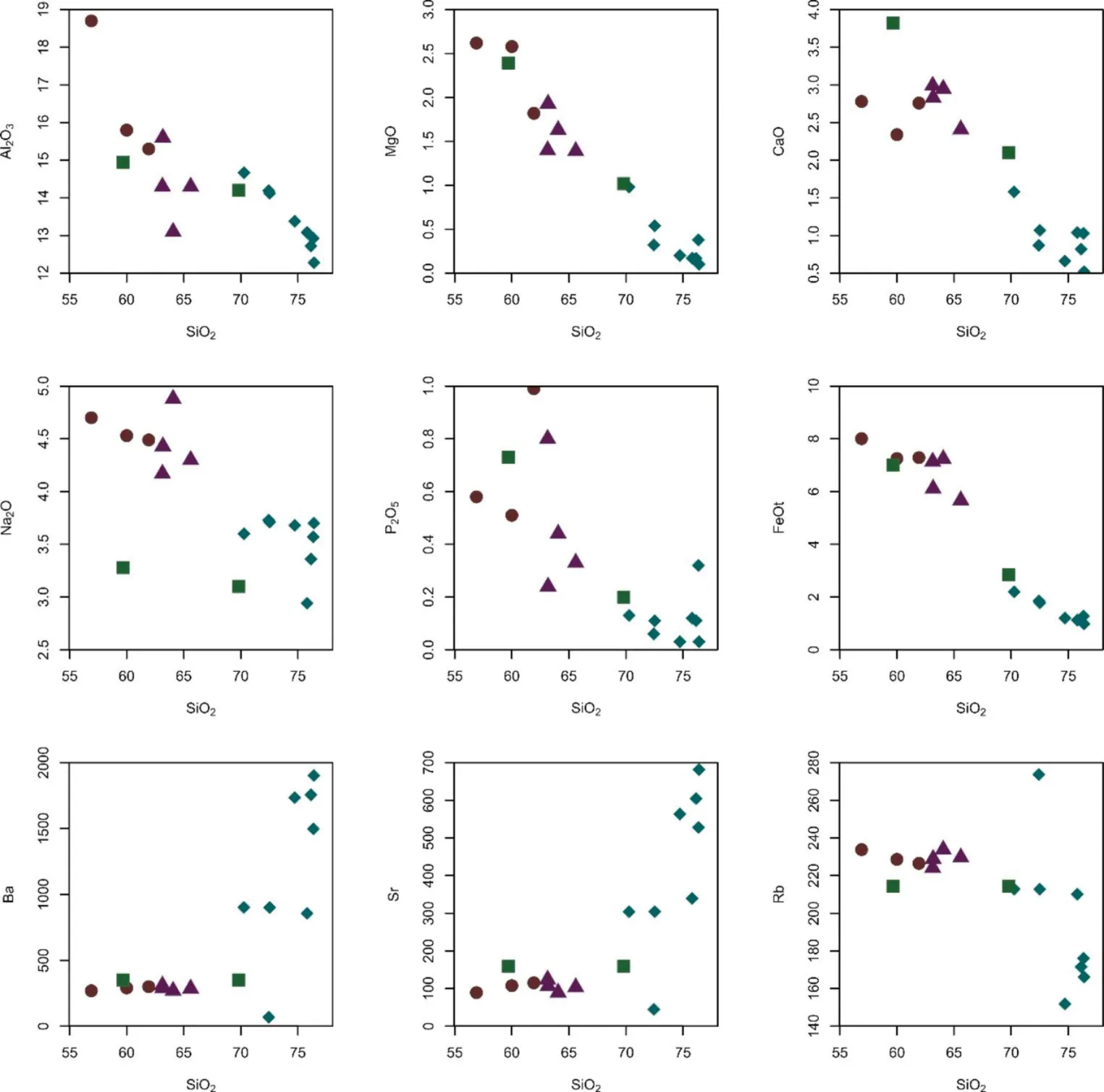
Fig.6 Harker diagram for major element contents in the Hangloa rocks
5 Discussion
5.1 Magmatic diff erentiation
Magmatic diff erentiation processes are the leading causes of lithological and geochemical variations in the composition of igneous rocks.The variation in igneous rocks across the Archean-Proterozoic transition have been a major subject of interest in global earth science research (Bucholz and Spencer 2019).This is evident in the Hangloa area where the granitoids show signif icant compositional variation.The Petrography shows both intermediate and felsic components, which indicates melt fractionation.The negative trend observed between the major oxides versus SiO2suggests fractionation from a common parent magma (Wilson 1978; Martin 1987; Sun and Nesbitt 1978; Sun et al.1989).However, Hacker diagrams for these oxides show scattering along the regression line, indicating a possible internal compositional variation or overlaps within the magmas.CaO content appears to be lowest in the granites, probably due to early fractionation of Ca-bearing minerals pyroxenes,amphiboles and biotite from the melt (Hassanen et al.1996).This may also signify variation in the degree of partial melting or contamination by subduction f luids.Major and trace plots versus SiO2also show curving as an indication of melt fractionation (Fig.6).This is also visualized by pronounced fractionation in the LREE relative to the HREE (Fig.7).The negative anomalies observed for Ba, Sr, Ti and Nb (Fig.7 a,c, e & g) suggest the sources were poor in these elements or retained in the residue during partial melting (Nzenti et al.2010).Meanwhile, fractional crystallization at a high degree of partial melting most likely caused Nb removal,while the inf lux of subduction f luids may contributed to Rb enrichment (Pearce et al.1984; Pearce 1996).But the negative Rb pattern observed maybe due to biotite decomposition.On the other hand, amphibole crystallization from the melt (Pearce 1996) caused a decrease in Nb and Y.The Eu trough indicates the removal of plagioclase by crystallization or retained in the source.Crustal contamination can be supported by the presence of maf ic enclaves in the granites(e.g.Castro et al.1999; Collins and Richard 2008).According to Torkian and Forman ( 2015), these enclaves result from the injection of pulses of maf ic magma into the granitic melts accompanied by rapid cooling.Magma mixing can be
excluded from the Hangloa peraluminous granites considering that the observed enclaves do not show chilled margins with the host granites and neither do they bear any visible k-feldspars and quartz minerals to support mixing (Chen et al.1990; Didier 1984).Moreover, no chemical analysis of the enclaves was done to justify the mixing/mingling mechanism.However, the major and trace elements plots against SiO2do not show any distinct patterns about the dominant trend.Thus, the scattering about the dominant trend is likely due to source heterogeneities rather than mixing.
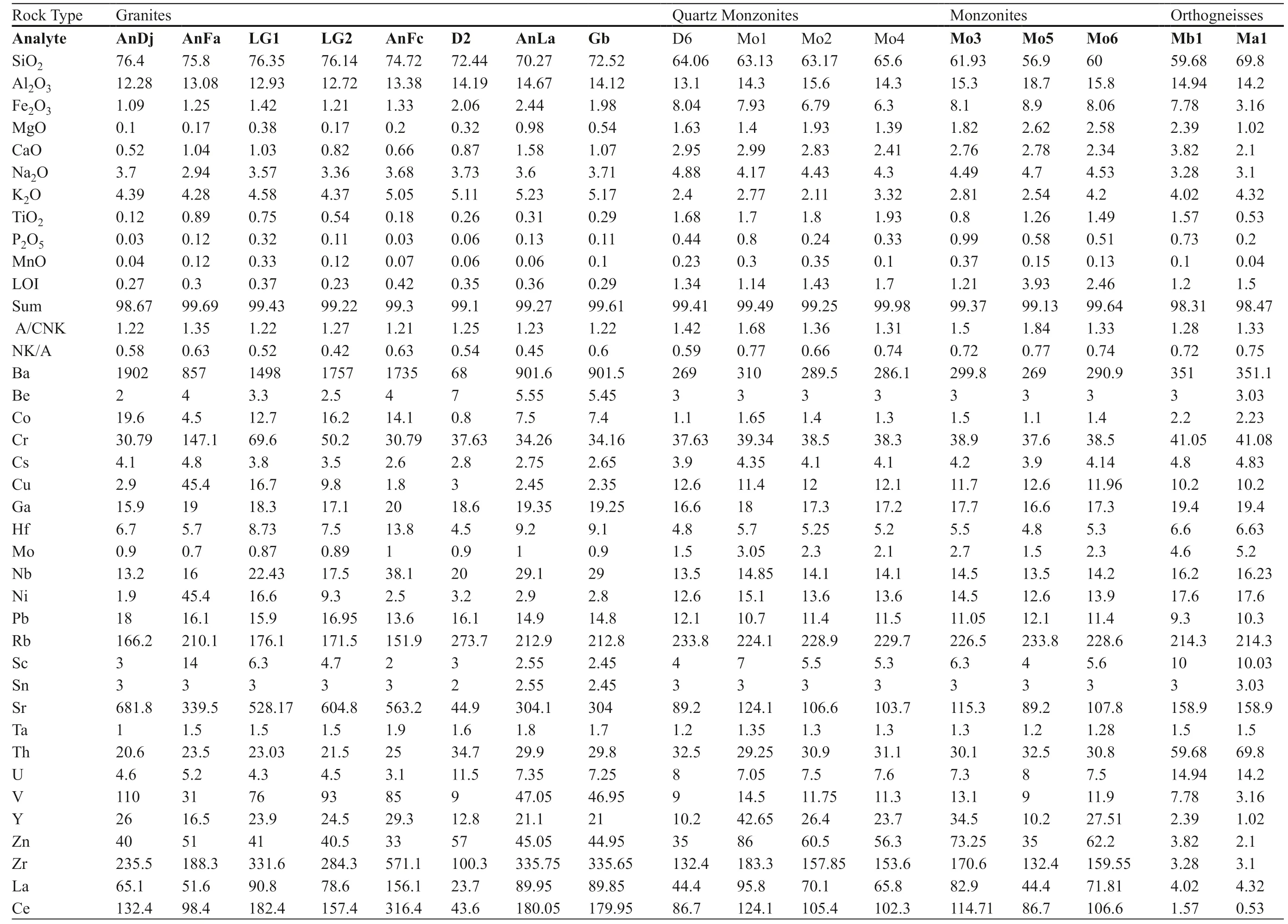
Table 1 Major (%) and trace (ppm) elements concentrations of Hangloa granitoids
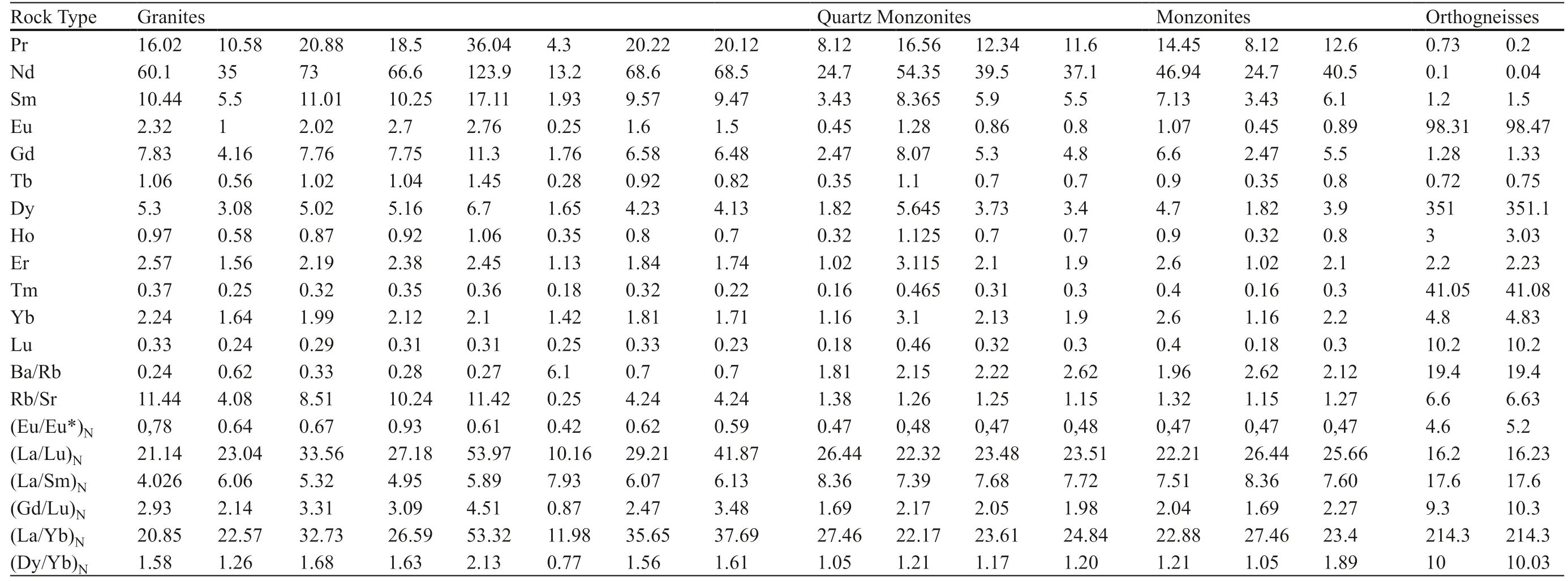
Table 1 (continued)
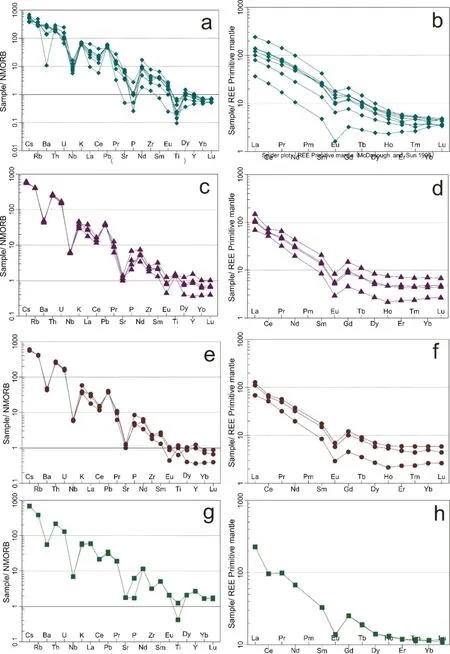
Fig.7 Spider diagrams for trace and REE in rock samples;NMORB normalization by Sun and McDonough ( 1989) and McDonough and Sun ( 1995)
Artemieva et al.( 2017) used U, Th concentration and ratios to characterize granitic rocks due to the variation of these elements over time, especially after the middle Proterozoic, which has been observed in several previous works (McLennen 2001; Vilà et al.2010; Merino et al.2013; Hacker et al.2011).However, Hangloa granitoids show U and Th concentrations varying from 3.1 to 11.5 ppm and 20.6‒34.7 ppm, respectively.These concentrations are higher than the mean crustal concentration for granites (Artemieva et al.2017).Similarly, their Th/U ratios range from 3.02 to 8.06, higher than the global mean of the primitive mantle and continental crust (Rudnick et al.1998; Kemp and Hawkesworth 2003; Bea 2012; Artemieva et al.2017).These signify that crystal fractionation (of minor phases,especially zircon and monazite) is not the only culprit here,but melt contamination and U mobilization during hydrothermal activity (Regelous et al.2021) were also involved.From all indications, the geochemical variations of these granitoid suites cannot be explained by melt fractionation alone considering that the patterns for the major oxides show a lot of scattering along the FC trend couple with the unusual behaviour of Ba and Sr showing enrichment in the granites while Rb shows a decease (Figs.6 and 7), thus source composition might be the culprit.
5.2 Magmatic source and evolution
Hangloa granitic rocks show signif icant variation in composition but display a strong peraluminosity (Fig.5 b).Based on previous reports, the crustal source for peraluminous granitoids is def ined by enrichment in LREE and LILE(McLennan 2001; Chappell et al.1991).Hangloa granitoids show high LILE content (Fig.7 b, d, f & g) , with Ba/Sr from 1.5 to 3.08, Ba/Rb from 1.15 to 11.44 and low Rb/Zr(0.53‒2.73).LILE are highly depleted at the lower crust,accounting for the depth diff erence and isotopic signature for the crustal source (Pearce 1996).However, Hangloa granitoids show enrichment in LILE (Table 1) and their high A/CNK (alumina saturation) make the upper continental crust a more suitable environment for these magmas.These variations are often caused by source heterogeneities leading to compositional variations amongst magmas(Patiño Douce and Johnston 1991; Harris and Inger 1992;Wilson 1989; Nzenti et al.2010).Moreover, peraluminous melts often display an S-type nature which often originates from shallower continental sources.This depth limit hinders suffi cient homogenization of the melt before diff erentiation as compared with I-type sources (Chappell 1996; Chappell et al.1991).However, source variation can be observed from the plot of the granitoids in the f ields of partial melting of metapelitic and metagraywackes (Fig.8 a) (Gromet et al.1984; Gerdes et al.2002).This diagram clearly shows that the granites have a diff erent source composition from the monzonites and quartz monzonites.Moreover, the granites have constantly plotted in separate f ields in the discrimination diagrams alongside sample Ma1 from the orthogneisses(Figs.8 a and b, 9 b and c, and 10 a and b).These observations generally suggested that at least two source materials were melted to generate the magma involved in the emplacement of these granitoids.
Hangloa granitoids plot mainly in the f ields of partial melting of metapelitic and partly metagraywackes (Fig.8 a)(Gerdes et al.2002) as an indication of their variable source composition and crustal origin (Gromet et al.1984).Villaseca et al.( 2008 a, b) indicated that the more maf ic granitoids show more pelitic metasedimentary sources, while the felsic granites are mostly derived from meta-igneous or mixed crustal-mantle sources 1998a b, 2008.Looking at the discrimination diagram of Laurent et al.( 2014), the granitoids show multiple sources involving metasedimentary,high-K maf ic and tonalitic rocks (Fig.8 b).Source heterogeneities, in this case, can be supported by P enrichment observed in the orthogneisses, monzonites and quartz monzonites and depletion in the granites.Hangloa granites also show CaO/Na2O < 0.3 which is indicative of metapelitic source (Sylvester 1998), but their Rb/Sr ≤ 1 instead shows a plagioclase-rich and clay-poor source for the peraluminous granites (Sylvester 1998; Nzenti et al.2010).Meanwhile,the high K2O, Ba, low CaO, Sr may have contributed to the strong peraluminosity of the Hangloa granitoids (Chappell et al.1991; Williamson et al.1997) although the abundance of hydrous minerals like quartz and feldspars in pelitic melts together with refractory materials with slight solubility such as Al2O3, Fe2O3, MgO and TiO2may also occur in excesses and thus make the pelitic source unsuitable for peraluminous magmas (Patino Douce and Junhson 1991).Since both high and low CaO/Na2O ratios were observed in the Hangloa granitoids, this indicates diff erent sources characterized by clay-poor and clay-rich content (Sylvester 1998;Bucholz and Spencer 2019).
Based on Collins and Richard (2008), granitic rocks with S-type character constitute an end product of a compositional spectrum.Thus, for a peraluminous melt to form, themetasedimentary proportion in the magma mixture (metaigneous or basaltic melts) must be relatively high (Collins 1996).Even though the Hangloa granitoids show several features common with strong peraluminous S-type magmas (Shand 1943; Maniar and Piccoli 1989), (Fig.5 b), the paucity of aluminium mineral in the observed thin sections suggest that the magma was derived from diff erent sources but suff ered insuffi cient time for homogenization of the melt before diff erentiation and emplacement.This can also be visualized from the ternary diagram for discrimination of magmatic sources that show scattering even though they plot within an S-type f ield (Fig.9 b).Meanwhile, in the discrimination diagrams for magmatic sources (Fig.9 a & c),the Sr/Y ratios for the Hangloa granitoids are generally < 30
with variable La/Yb against SiO2.These proxies signify a partial melting of the sources under low pressure and high temperature with signif icant residual plagioclase involved(Gao et al.2016; Wang et al.2016).

Fig.8 Discrimination diagrams for magmatic source; (a) CaO/MgO +Fe2O3 (Gerdes et al.2002); (b)ternary diagram of Al2O3/(Fe2O3 + MgO)-3CaO-5*Na2O/K2O (Laurent et al.2014)

Fig.9 Discrimination diagrams for magmatic source (a, b & c are after Wang et al.2016); (a) SiO2 vs.La/Yb show variation; (b) SiO2 vs.Sr/Y with ratios of Sr/Y < 30; (c) La/Yb vs.Sr/Y all plot in F2 f ield and Sr/
On the contrary, the presence of kyanite in the mineral fraction, even though in a very small amount, indicates higher pressure conditions for the melts.Meanwhile, the La/Yb vs.Sr/Y diagram shows the samples plotting in the F2 f ield, which according to Wang et al.( 2016), represents a magma source with signif icant plagioclase stability and little or no garnet involved.However, this can further be verif ied with microprobe analysis of the minerals, including the opaques.Sylvester ( 1998) observed a link between Yb values < 45; (d) A/CNK value above 1.1 but show some scattering(after Gao et al.2016)
Al2O3/TiO2ratios and magmatic temperature.Taking into account that partial melting of crustal rocks (or anatexis)is governed by the melting temperature, they discovered that Al2O3/TiO2ratios < 100 correspond to higher Zr values(> 100 ppm).At Zr concentration > 100 ppm, as observed in Hangloa granites except for one granites sample (AnDj)with Al2O3/TiO2<100, the saturation temperature around 807 ± 105 °C is attained (Sylvester 1998; Bucholz and Spencer 2019).This temperature might ref lect primary melting temperature or secondary cooling temperature (Finger and Schiller 2012).However, the high melting temperature conforms to high-grade metamorphic events within the central domain of Cameroon (Tchaptchet et al.2009).
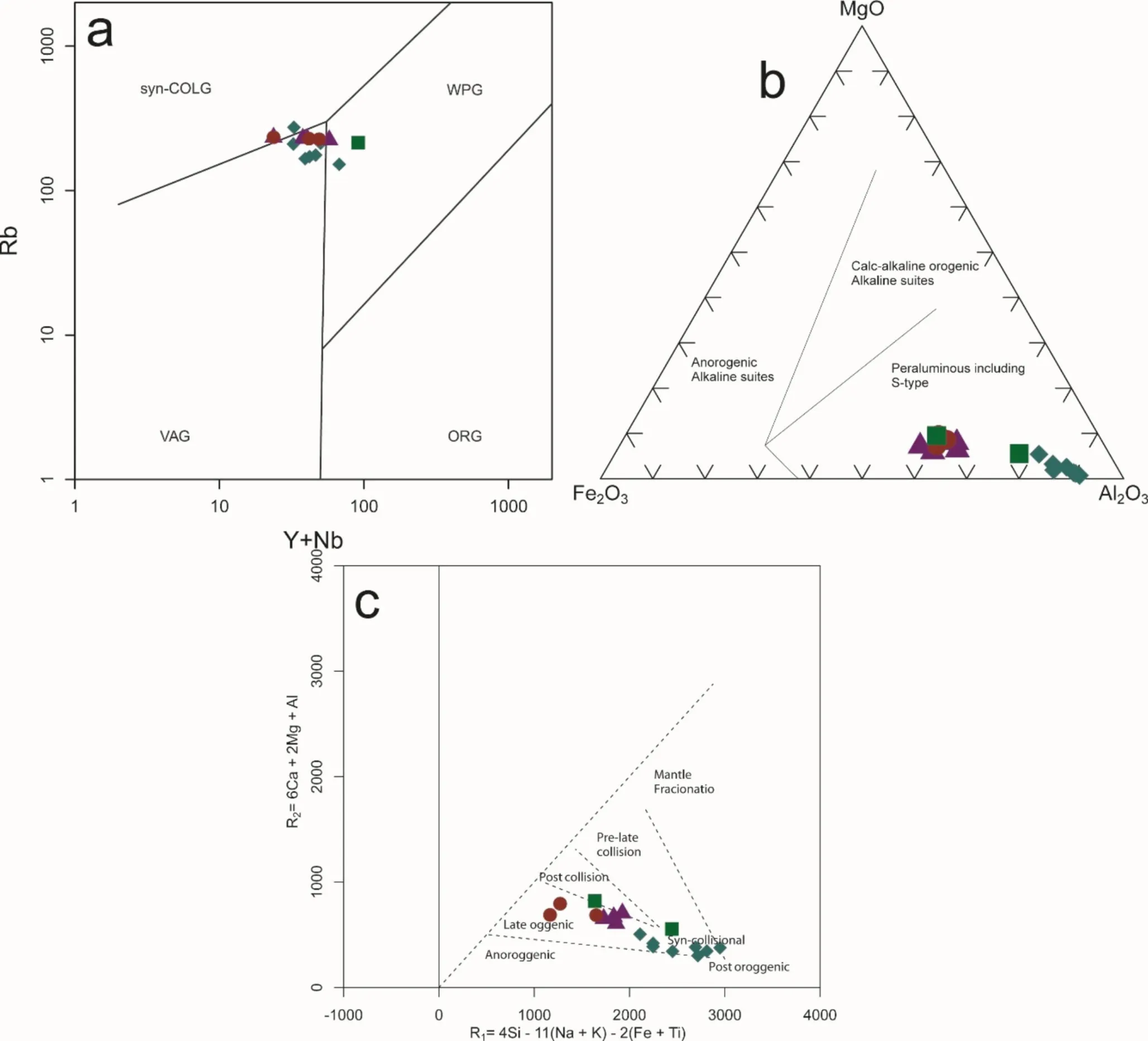
Fig.10 Discrimination diagrams for tectonic setting of Hangloa granitoids; (a) Y + Nb vs.Rb (Pearce et al.1984); (b) ternary diagram of Fe2O3-MgO-Al2O3 (Abdel-Rahman 1994); (c) R1-R2 diagram (Batchelor and Bowden 1985)
5.3 Tectonic setting
Most strongly peraluminous granitic provinces worldwide are linked to convergent plate margins involving cratonic and mobile blocks, which eventually marks the transition between Archean-Proterozoic units.Hangloa granitic rocks display chemical features that show their strong peraluminous S-type affi nity (Fig.5 b) (Shand 1943; Maniar and Piccoli 1989; Gao et al.2016).Their tectonic setting plots within the volcanic arc geotectonic environments, with a slight overlap between syn-tectonic and intraplate f ields(Fig.10 a & c).This intermediate position is typical of a post-collisional setting (Pearce et al.1984; Liegeois et al.1994).
According to Pearce ( 1996), the post-collisional magmas usually have mantle and crustal components resulting from the continental crust and/or igneous sediments subduction into the mantle and enriching mantle melts leading to Rb enrichment.For the Hangloa granitoids, these can be related to the slight diff erences in their Y and Nb content (Pearce et al.1984) and cationic proportions (Batchelor and Bowden 1985).Together with the high-K calc-alkaline to shoshonite nature of the granitoids, these characteristics conform to the collisional orogenic setting (Pearce 1996; Liégeois et al.1998).Moreover, orogenic belts are known to host transitional granitoids that coexist as metaluminous and peraluminous S and I-type end members (Chappell 1996; Tung et al.2016; Lopez et al.2018).This coexistence has been reported within the WCD and AYD of the Cameroon CAFB(Djouka-Foukwé et al.2008; Nzenti et al.2010; Nlend et al.2009; Kouankap-Nono et al.2010; Ganwa et al.2011).
In the diagram of Batchelor and Bowden ( 1985), the rocks plot in the syn- to post-collisional f ields.These tectonic settings correspond to D2to D3deformation within the CAFB in Cameroon.The assembly of Gondwana during the late Neoproterozoic saw a substantial accretion of juvenile crust across the CAFB during which most Pan-African granitoids were emplaced dating 640 to 580 Ma (Toteu et al.2001).
5.4 Geodynamic implication
The source rocks for Hangloa show metapelites and mixed metagreywackes/metapelitic melts (Fig.8 a).Reports show that crustal sources for granitic rocks with high P content are pelitic shales (Gromet et al.1984).Meanwhile, Villasseca et al.(2008) established a correlation between peraluminous granitic rocks and schist belts.In their reports,most P-rich granitoids were conf ined within schist belts of Neoproterozoic age.A similar schist setting is reported in SW Nigeria that host several peraluminous intrusions (Oluwatoyin et al.2021).This geotectonic environment resembles that of Hangloa if we consider its proximity to the Poli schist belt (Toteu et al.2001).Previous reports highlighted a major lithological relationship between the Borborema province of NE Brazil and the CAFB in Cameroon, such as the occurrence of metasedimentary units within the geotectonic domains (Ganwa et al.2011; Toteu et al.2001).Hangloa granites show partly metasedimentary source with the presence of kyanite as a peraluminous indicator similar to metasedimentary minerals (garnet-kyanite-Staurolite) in the Poli basin (Toteu et al.2006).In this regard, there is a high chance that the metasedimentary material from the Poli basin contributed to the melt of the Hangloa granites.On the other hand, the monzonite and quartz monzonite show elevated P content similar to that of basaltic rocks from the Hangloa area.The diff erence in composition supports multiple source compositions of the magma in the area.Although, volcaniclastic material from the Hangloa lake basin may have contributed to melts given that basalts from the study area show high P content coupled with reports on vivianite (hydrated iron phosphate mineral) deposited in the area (Fodoué 2015).These suggest variable provenance for the Neoproterozoic basin in these regions and, thus, contributed to the source heterogeneities of their magmas (Van Schmus et al.2000; Toteu et al.2001).
Moreover, the composition of the Hangloa granitic rocks are similar to most tectonic zone within the CAFB in Cameroon, such as the high-K calc-alkaline to shoshonite affi nity(Tchamini et al.2006; Ganwa et al.2011).The peraluminosity of the granitoids also show similarity to S-type granites from WCD (Nzenti et al.2010) and SE Brazil (Potratz et al.2021).Information on the evolution of the CAFB in Cameroon shows that the convergence and collision between the stable Congo Craton and two Paleoproterozoic-Poli belts and Adamawa domain characterized the Pan-African orogeny in Cameroon (Toteu et al.2001).Thereafter, the Adamawa-Yadé Domain suff ered intense crustal deformation and melting in the early Neoproterozoic.This event progressed in the Late Neoproterozoic with the collision and assembly of west Gondwana involving general anataxis within the continental crust, intense melting, thrusting onto the Congo Craton and plutonism (Toteu et al.2001).Sedimentation, however, may have taken place before the emplacement of syn-tectonic (Early Neoproterozoic) intrusions within the AYD of the CAFB dating 735 to 612 Ma(Toteu et al.2006; Ganwa et al.2011).
6 Conclusion
● The petrography and whole-rock geochemistry of the Hangloa granitic rocks show that they were derived from anatetic melts within the crust with pulses of maf ic mantle input, then fractionated at diff erent levels within the crust.Diff erent degrees of partial melting was involved under high temperature (around 800 °C) conditions as indicated by Al2O3/TiO2ratios < 100, with Zr content > 100.
● High aluminium saturation, high LREE, low LILE and volcanic arc setting strongly support the upper crustal origin.They display high-K calc-alkaline to shoshonite affi nity indicating close association with subduction processes that involved the northern block and the Congo Craton of Central Cameroon.
● The variation in the composition of the granites show that at least two source materials were melted to form the Hangloa magma including metapelitic, metagreywackes and high-K maf ic components due to the variable CaO/Na2O, Rb/Sr and P content indicative of clay-poor and clay-rich source material.
● Even though the granitic rocks show petrochemical features similar to standard S-type granitoids, with A/CNK > 1.1 and metapelitic sources, the scarcity of aluminium minerals in the observed thin sections suggests source depletion or disproportionate melting of metaigneous and metasedimentary materials.Thus, there is a need for further microprobe and Isotope analysis for verif ication.
AcknowledgementsThe authors wish to appreciate the f inancial and technical support received from the Geoscience Laboratories in Toulouse (LGT) France under L’Agence Universitaire de la Francophonie(AUF) project during the analysis of the samples and thin section preparation.
Authors contributionOn behalf of all authors of this work, the corresponding authors hereby declare that this work has received contribution from all authors listed.The f ieldwork was done by the corresponding [YF], assisted by WJW, ADK, AM, and ENN and supervised by 4th author RT.First Draft was written by the corresponding author YF and MY.The draft was corrected by RT and JP.The f inal work was read and approved by all authors.
FundingI declare that no direct funding was obtained for this work.However, technical support was provided in the observation of thin section in the Laboratory of Toulouse, France.
DeclarationsConf lict of interest The authors declare that they have no conf licting interests that could inf luence the publication of this work.
杂志排行
Acta Geochimica的其它文章
- Fractionation mechanism of iron isotopes in highly fractionated granites from the Xinxian Pluton,Western Dabie Orogen,Central China
- Fluid inclusion studies of the Kenticha rare-element granitepegmatite, Southern Ethiopia
- Petrogenesis and tectonic implications of Late Triassic granitoids in the Alananshan,East Kunlun belt:evidence from geochemistry,geochronology, and zircon Hf isotopic compositions
- TiO2 nanoparticles in aquatic environments: impact on heavy metals distribution in sediments and overlying water
- Comparing mineral weathering and elemental transport between earth’s critical zone with different parent rocks in Yanshan Mountain, Hebei province, China
- Geochemistry and crystal shape, size and spatial distribution in arc-related gabbro, Urmia, NW Iran
